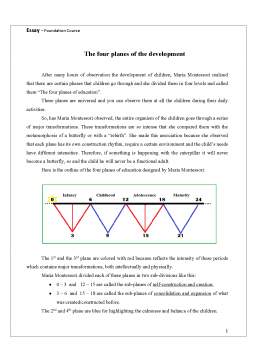Extras din referat
After many hours of observation the development of children, Maria Montessori realized that there are certain phases that children go through and she divided them in four levels and called them “The four planes of education”.
These planes are universal and you can observe them at all the children during their daily activities.
So, has Maria Montessori observed, the entire organism of the children goes through a series of major transformations. These transformations are so intense that she compared them with the metamorphosis of a butterfly or with a “rebirth”. She made this association because she observed that each plane has its own construction rhythm, require a certain environment and the child’s needs have different intensities. Therefore, if something is happening with the caterpillar it will never become a butterfly, so and the child he will never be a functional adult.
Here is the outline of the four planes of education designed by Maria Montessori:
The 1st and the 3rd plane are colored with red because reflects the intensity of these periods which contains major transformations, both intellectually and physically.
Maria Montessori divided each of these planes in two sub-divisions like this:
- 0 - 3 and 12 - 15 are called the sub-planes of self-construction and creation;
- 3 - 6 and 15 - 18 are called the sub-planes of consolidation and expansion of what was created/constructed before.
The 2nd and 4th plane are blue for highlighting the calmness and balance of the children.
The first plane 0 - 6 years
“Touching for a younger child is what imagining is for the older” - pg.22- From childhood to adolescence
It is the most important one because if this plane is not completed, the construction of the human being will not be held. The reasons for that are all the psychical developments which are happening in this period.
Here in the beginning, the baby is completely dependent of the adult to fulfill his basic needs. Now he doesn’t know how to communicate, his movement is not coordinated and that why the adult becomes his first model for everything.
In the 0 - 3 years (“unconscious creator”) the child is half of the time at home and half at school, that’s why both of the environments have to be prepared in the way that offer’s him opportunities to interact with real objects through his senses. The furniture should be corresponding to his size and like these they can work and gain independence. The environment should offer them the possibility to move, to get dress, to toilet self, to express their taught etc.
For the 3 - 6 years old (“conscious worker”) children Maria Montessori created an appropriate environment for them called “Casa dei bambini”, where she made the furniture on their size, she organized the materials from simple to complex and she create an atmosphere of calmness and peace.
“Our work is not to teach, but to help the absorbent mind in its work of development”. - pg.22 - Absorbent mind by Maria Montessori
Now children have a unique opportunity called by Maria Montessori “The absorbent mind”, when his mind absorbs everything totally and indiscriminate (feelings, emotions and all intangible things that he meets), like a “sponge”; and nothing from this period can be erased ever.
During 0 - 6 years he is exploring the world in a sensitive way and he have to adapt to the real world using all his senses, reason for why the TV and PC are not recommended, because are presenting imaginary things.
In this plane he begin to lay the foundation of his personality, he starts to desire to choose, he want to do things by his own. But the big transformation is in his organism, especially in his mind where are created new brain connections, developing him intellectually.
At 6 years the absorbent mind fades out and you can observe how self-construction went till now.
Bibliografie
The Absorbent Mind Mario Montessori Vasanta Press 1949
From Childhood to Adolescence
The four planes of Education Maria Montessori
Mario Montessori Clio Press Ltd.
AMI print 2000
2015
Preview document
Conținut arhivă zip
- Cele 4 planuri ale educatiei - Montessori.docx












